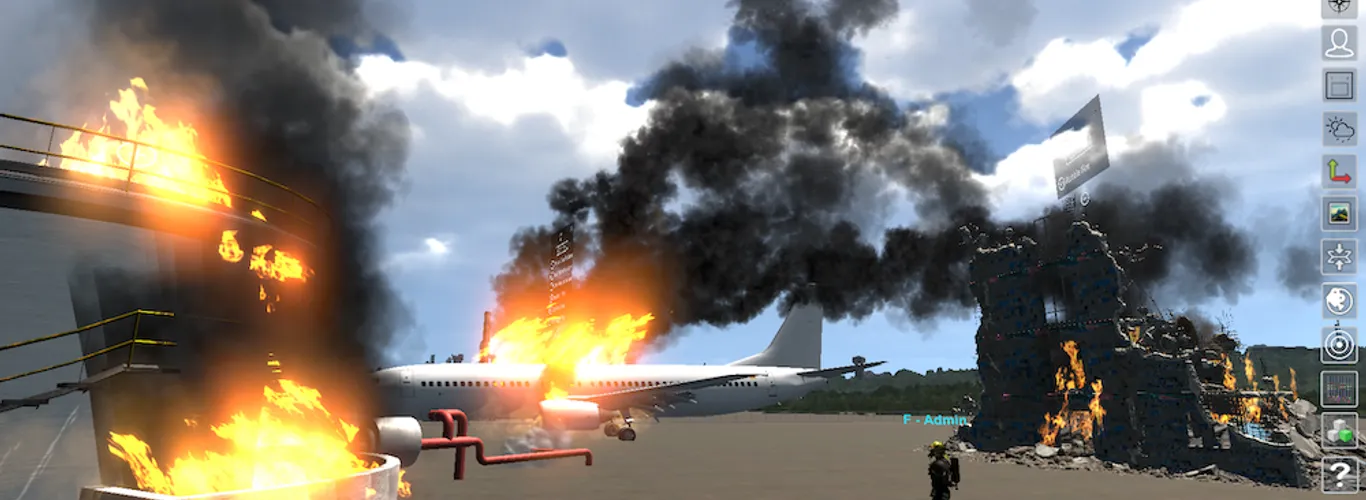
Introduction
Airports, training academies, fire services, oil & gas companies and businesses working in high-risk environments that deliver training both to their own staff and on a commercial basis currently have access to conventional tools. These include options such as tabletop exercises where members meet in an informal classroom setting to discuss roles and responsibilities during an emergency and form responses to a particular situation using basic, limited resources, or computer-based training aids such as PowerPoint presentations with images and videos. At the other end of the spectrum, simulated real life large exercise drills can be conducted using complex and expensive command and control software, these can take time to learn to operate and cost tens or hundreds of thousands of dollars.
As specialists in this field, we identified a gap for solutions to enable fire chiefs and training managers to provide better training for their teams. We also observed that preparing training material and finding the right images and video content on the internet can be a time-consuming and hit-and-miss task that does not guarantee the same training experience across trainees and cohorts. This practice also meant that training managers could be using the same photos or videos on their computers over long periods of time due to the lack of new suitable interactive content which facilitates a beneficial training sessions and also impacts training quality.
Furthermore, companies with existing training grounds often intend to replicate physical training in a virtual environment before they go out and conduct the “real” training outside. They want to replicate that live training in a safe virtual setting that looks and feels exactly like the facility they already have to conduct briefings, debriefings and pre- incident planning sessions. There was no tool available for these professionals to quickly put together a virtual training facility and facilitate classroom-based training prior to real- life evolutions, which would result in an improved training experience for students and instructors alike.
With the available solutions on hand, scenarios were limited, repetitive, and instructors do not have the flexibility to create as many training scenarios as they would like. Our concluding insight was therefore that, due to the high cost of training software, a wide range of training was not available for everyone and that, as a result, it was difficult for trainees to understand the underlying hazards and risks in certain environments correctly.
So, what could be a good solution to solve these problems and enable chief fire officers and training managers to easily put together an interactive training scene, in a collaborative manner that does not cost tens of thousands of dollars? And how can watch managers at remote fire stations maintain their competencies and keep their teams up to date with their training in a cost-effective way?
Features & Benefits
Given all the above issues and the difficulties emergency response professionals face, we set about creating a solution to enhance their training experiences using a collaborative model where everyone shares their experiences and knowledge to benefit the industry, provide better training for all and at a lower cost across unlimited training scenarios.
We have simplified the process of building interactive virtual training environments for everyone working in a high-hazard industry, so that better training experiences can be delivered to their teams.
With STRX, the new training experience platform, we aim to improve the quality of training being delivered at every location - be it an oil company, a training institution, or an airport.
Our interactive and affordable solution empowers training managers to recreate simulated hazardous environments in under 5 minutes, and it enables them to conduct hazard identification and risk assessment processes more clearly and easily for their teams. The benefits of having such a training aid is not only being able to deliver better guidance and understanding of the risks involved in a safe environment across a wide range of potential scenarios, but also ensuring that when first responders are faced with similar incidents in real life situations they are familiar with it, and they have had the proper training to deal with a wider range of such situations effectively.
The advantages this solution brings to the training industry are many, as it has been organically designed to be collaborative and based on information as well as knowledge sharing.
With STRX, simulating real life training environments has never been easier. Training managers can swiftly switch between different settings, and with the online multi-user functionality, instructors are able to add colleagues from different locations to join the same training session. With a click of a button, they can add content from a diverse library of scenarios and hazards which are designed to replicate their real settings. Training managers can talk, chat, and collaborate with their teams locally and remotely all through the same platform so there is no need to use another software.
To facilitate better information sharing, we created an optional means to save and upload designs by any user worldwide so that others can benefit from their experience too. Additionally, scenario content is collaborative, so that, if any customer asks for a certain scenario or a hazard that is not included in the current library, we will add it to the next software update and make it available to all subscribers according to their subscription tier. To facilitate such a versatile training platform at a low cost, we followed a “software as a service subscription” model whereby customers choose from 3 different levels according to their training need and team size. By following this model we aim to facilitate better information sharing and make the training industry less fragmented and more collective, we also hope that by following this model information will be shared between people improving training quality and knowledge worldwide.